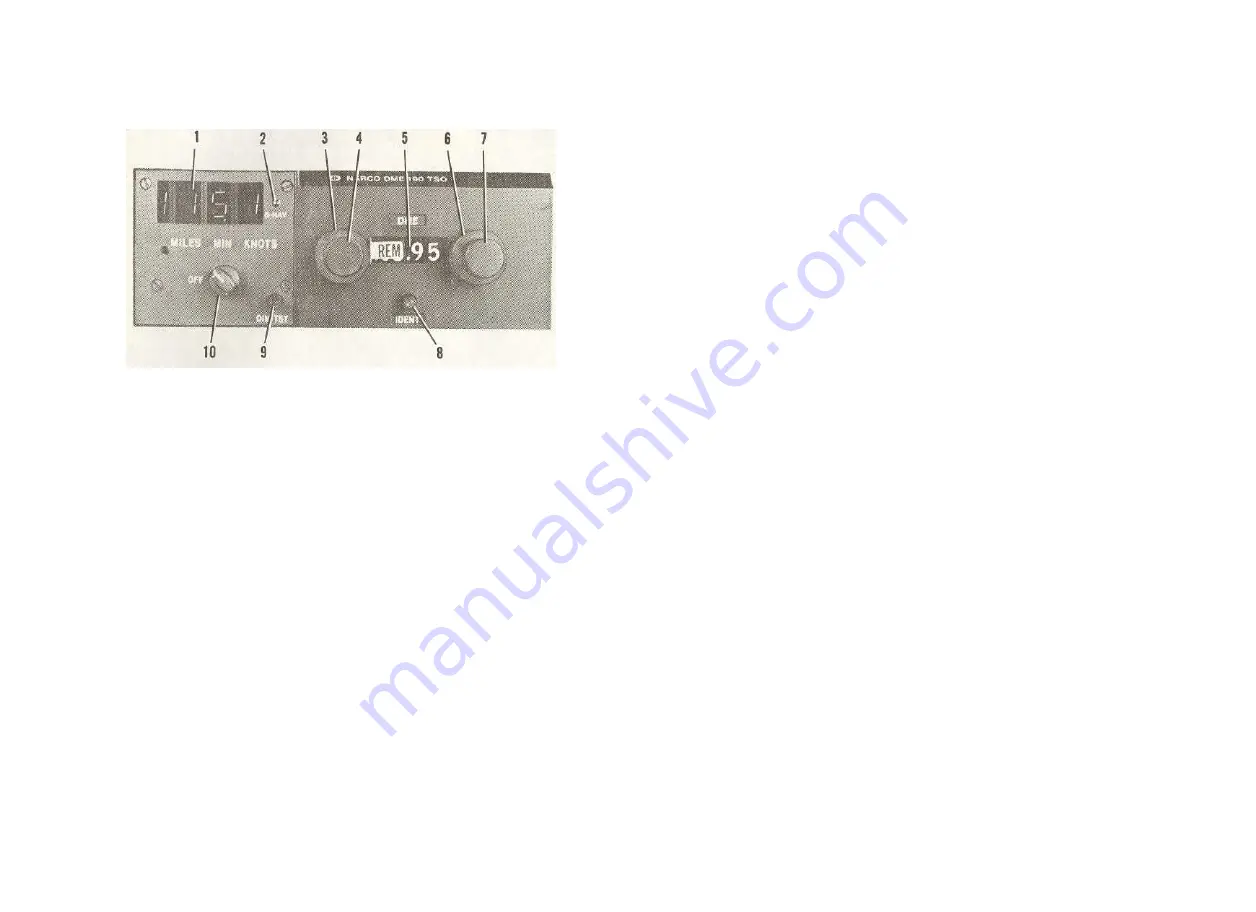
6
DME
PILOT'S OPERATING HANDBOOK
(TYPE 190)
SUPPLEMENT
1. READOUT WINDOW - Displays function readout in nautical miles (
distance-to-station), minutes (time-to-station) or knots (ground speed).
2. R-NAV INDICATOR LAMP - The green R-NAV indicator lamp is provided to
indicate the DME is coupled to an R-NAV system. Since this DME is not factory
installed with an R-NAV system on Cessna airplanes, the R-NAV indicator lamp
should never be illuminated. However, if an R-NAV system is coupled to the DME,
and when in R-NAV mode, the R-NAV lamp will light which indicates that the
distance readout is the "way point" instead of the DME station. The DME can only
give distance (MILES) in R-Nav mode.
3. REMOTE CHANNELING SELECTOR - Two position selector. In the first posi-
tion, the DME will utilize the frequency set by the DME channeling knobs. In the
second position, the MHz digits will utilize the frequency set by the NAV 1 unit's
channeling knobs.
4. WHOLE MEGAHERTZ SELECTOR KNOB - Selects operating frequency in 1-
MHz steps between 108 and 117 MHz.
5. FREQUENCY INDICATOR - Shows operating frequency selected on the DME or
displays remote (REM) flag to indicate DME is operating on a frequency selected
by the remote NAV 1 receiver.
6. FRACTIONAL MEGAHERTZ SELECTOR KNOB - Selects operating frequency
in 50 kHz steps. This knob has two positions, one for the 0 and one for the 5.
7. FRACTIONAL MEGAHERTZ SELECTOR KNOB - Selects operating frequency
in tenths of a Megahertz (0-9).
Figure 1. DME 190 Operating Controls (Sheet 1 of 2)
2
1 July 1979
6
PILOT'S OPERATING HANDBOOK
DME
SUPPLEMENT
(TYPE 190)
8. IDENT KNOB - Rotation of this control increases or decreases the volume of the
received station's Ident signal. An erratic display, accompanied by the presence
of two Ident signals, can result if the airplane is flying in an area where two
stations using the same frequency are transmitting.
9. DIM - TST KNOB -
DIM: Controls the brilliance of the readout lamp's segments. Rotate the
control as desired for proper lamp illumination in the function window
(The frequency window is dimmed by the aircraft's radio light dimming
control).
TST (PUSH TEST): This control is used to test the illumination of the readout
lamps, with or without being tuned to a station. Press the control, a
readout of 188 8 should be seen with the mode selector switch in the MIN or
KNOTS position. The decimal point along with 188.8 will light in the
MILES mode. When the control is released, and had the DME been
channeled to a nearby station, the distance to that station will appear. If
the station channeled was not in range, a "bar" readout will be seen (--,- or
10. MODE SELECTOR SWITCH -
OFF: Turns the DME OFF.
MILES: Allows a digital readout to appear in the window which represents
slant range (in nautical miles) to or from the channeled station.
MIN: Allows a digital readout (in minutes) to appear in the window that it will
take the airplane to travel the distance to the channeled station. This time
is only accurate when flying directly TO the station and after the ground
speed has stabilized.
KNOTS: Allows a digital readout (in knots) to appear in the window that is
ground speed and is valid only after the stabilization time (approximately
2 minutes) has elapsed when flying directly TO or FROM the channeled
station.
Figure 1. DME 190 Operating Controls (Sheet 2 of 2)
1 July 1979
3












































